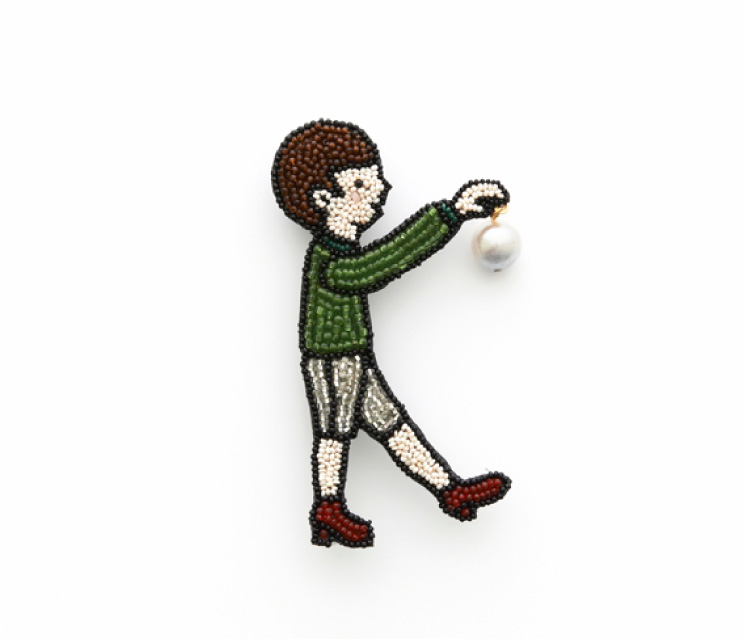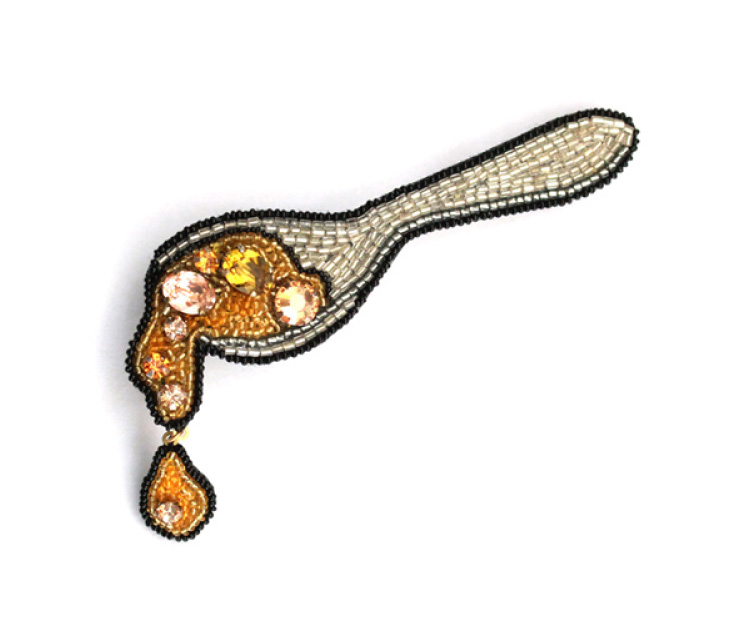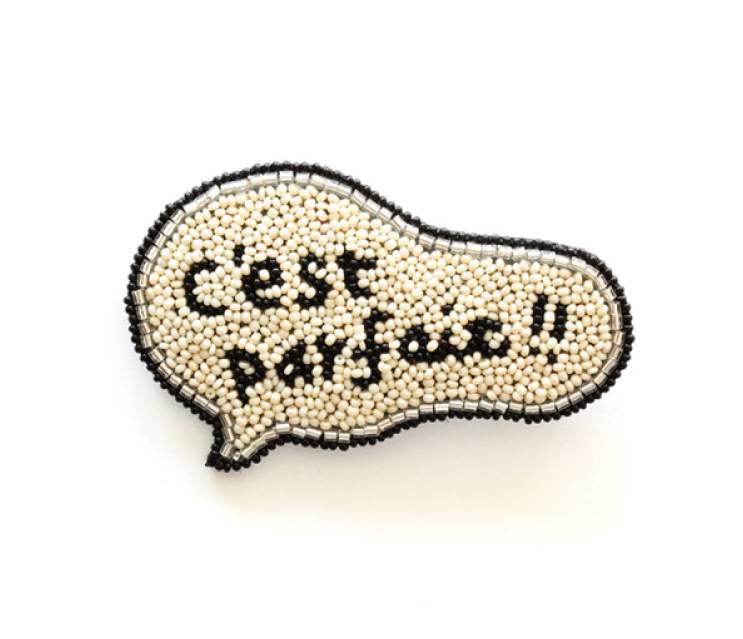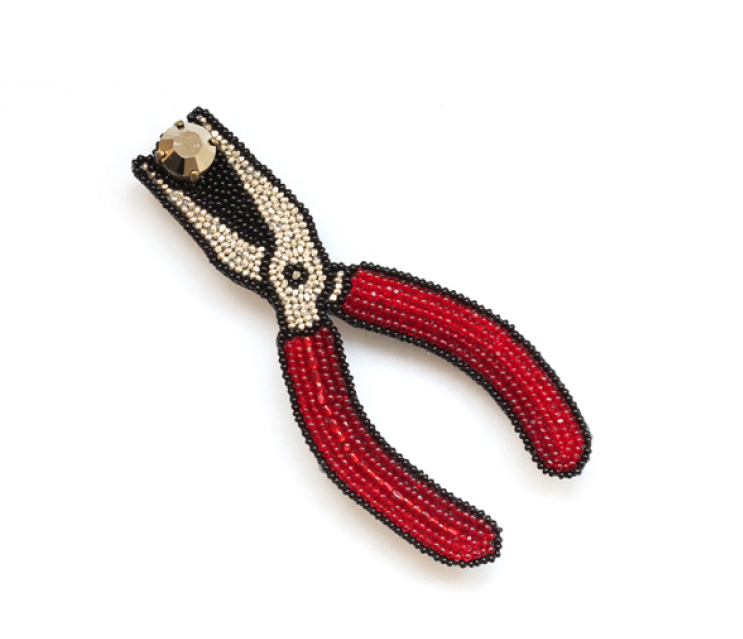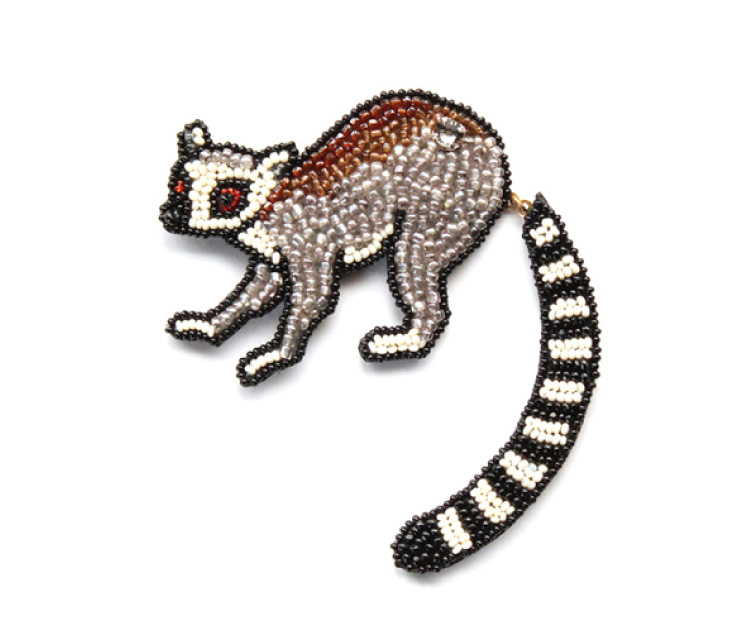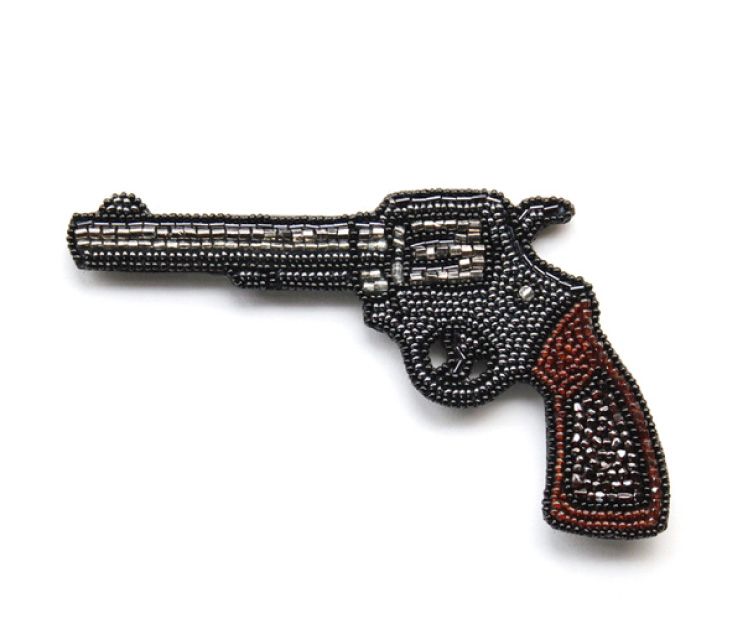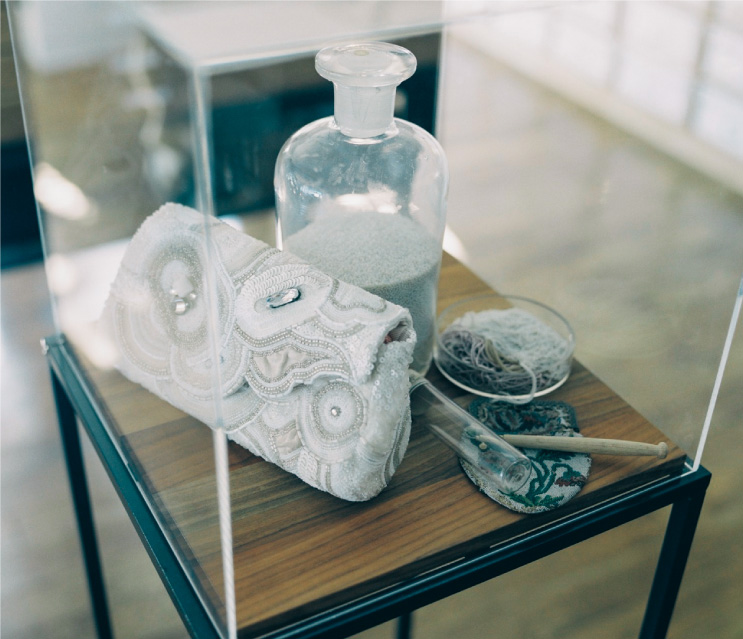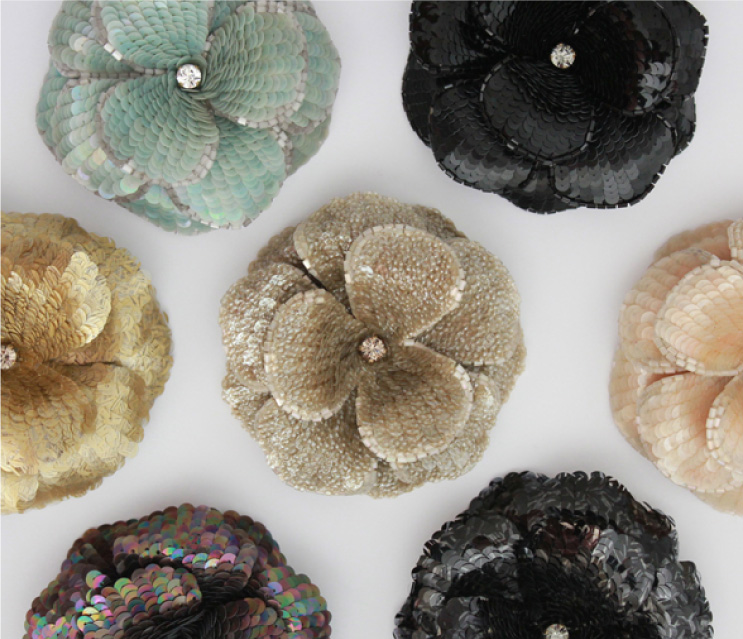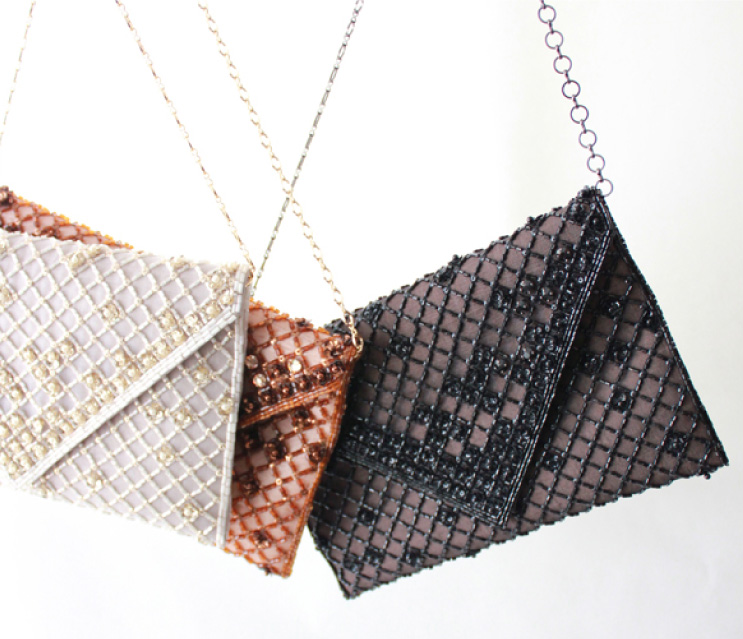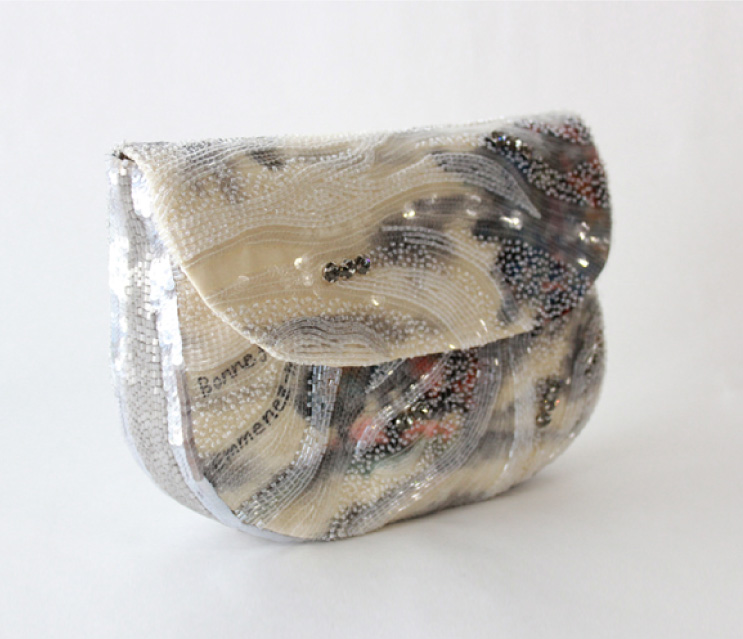小林モー子
刺繍家/Embroidery Artist

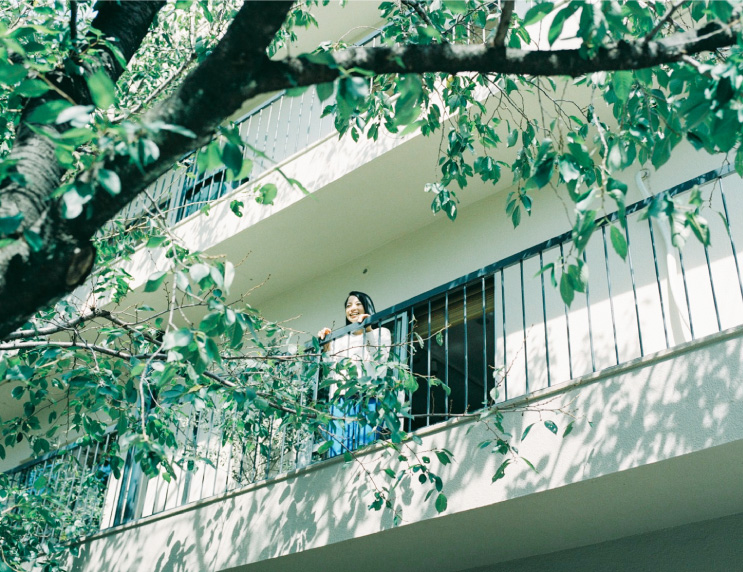
人と会うのが楽しくなる。
ビーズが織りなす幸せなものづくりの世界
The world of happy creation woven by beads
フランスの伝統的な技法であるオートクチュール刺繍と、ヨーロッパ各地で集めたヴィンテージビーズによって生み出されるユニークなブローチアクセサリー。そのどれもが身につけた人や目にした人をクスッとさせる、愛とユーモアに満ちている。この表情豊かなアートピースを手がけるのは刺繍家の小林モー子さん。単身フランスへ渡りクロッシェ・ド・リュネビルという、かぎ針を使った伝統的な刺繍技法を習得し、独自の世界観で刺繍の新たな領域を拡張しながら作品を発表している。目にした人を幸せにするクリエイティビティの源泉、モー子さんのアトリエを訪ねた。
The unique broach accessories which are created by Haute Couture embroidery, a French traditional technique, and vintage beads from various parts of Europe; each piece is full of love and humor that will give you a little chuckle. It is Môko Kobayashi, a needlework artist, who creates those expressive art pieces. After acquiring crochet de luneville in France, a traditional embroidery technique with a crochet needle, she has been publishing works expanding the field of embroidery with her unique worldview. We visited her atelier, the source of her creativity that makes people happy.
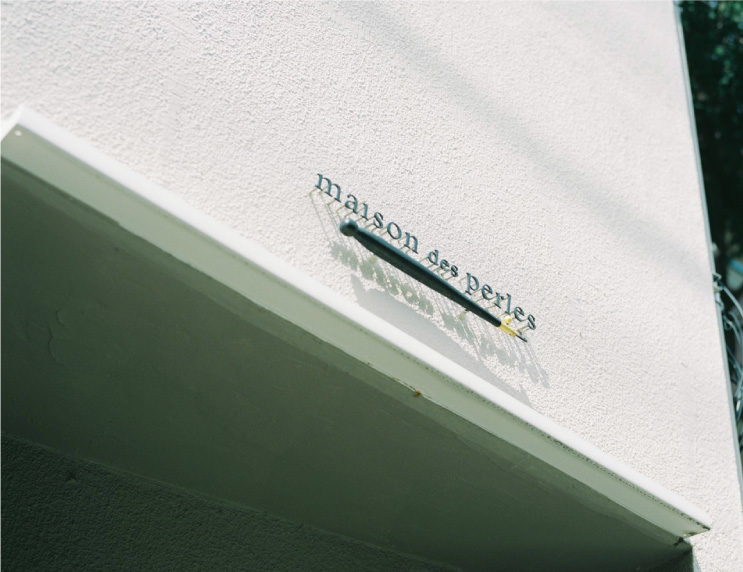


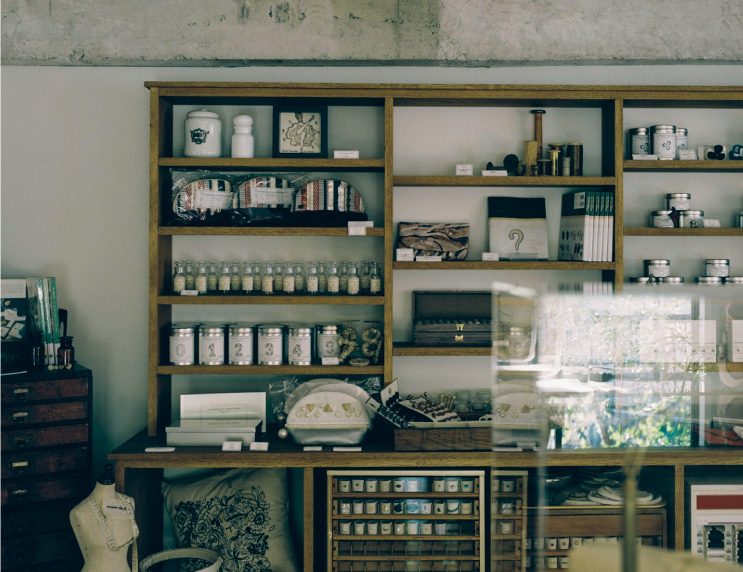
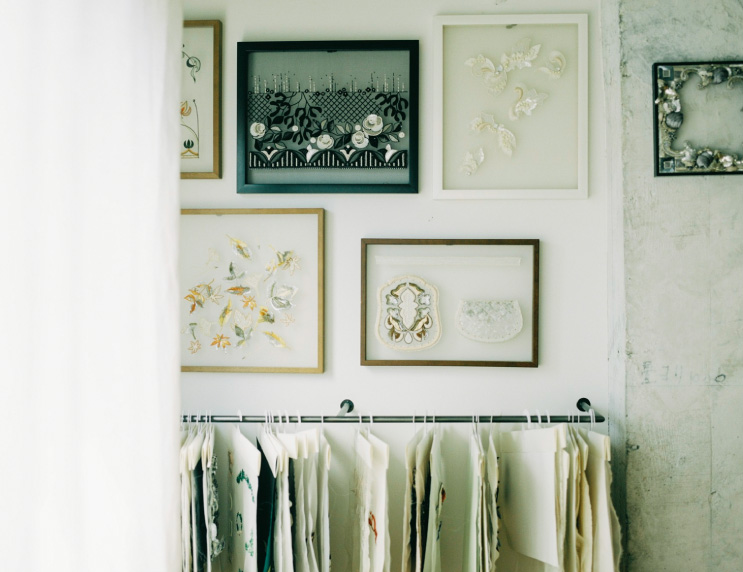

“piece de conversation”.
小さなブローチに込めた楽しい仕掛け
A fun trick in a small broach
東京・渋谷区西原の静かな住宅地の一角に、刺繍家・小林モー子さんが主宰する「maison des perles」(メゾン・デ・ペルル)のアトリエはある。まず視界に飛び込んできた大きな桜の木を仰ぎ見ていると、ちょうど一階のカフェでコーヒーを注文していたモー子さんが声をかけてくれた。「春には2階のアトリエからお花見ができるんですよ」快活な笑顔、チャーミングな笑い声とともに颯爽と通していただいたアトリエには、小さなビーズ作品たちが整然と並んでいる。そのひとつひとつが個性豊かな表情でこちらに語りかけてくるようだ。「モチーフになるのは、ありそうでなかったもの。例えばビールジョッキのような男性的なものや、ちょっとリアルな心臓だったり。また何かの動きの瞬間を捉えたものもよくモチーフになります。例えばミルクがこぼれる瞬間や、クラッカーが弾ける瞬間など…」。
“piece de conversation(話題の手がかり)” モー子さんが作品を作る時にテーマとして大切にしていること。「作品が会話のきっかけになって、新しいつながりが始まってほしい」。このアトリエで生みだされる小さなアートピースにはそんな思いが込められている。
An atelier of “maison des perles”, run by a needlework artist Môko Kobayashi, is located in a quiet residential area in Shibuya, Tokyo. When I was looking up to a big cherry tree which came into my sight first, Môko kindly spoke to me. She was just ordering coffee at a café on the first floor. “In spring, we can enjoy viewing cherry blossoms from our atelier on the second floor”, she gallantly showed us to the atelier with a cheerful smile and charming laughter. Each of those small beads works, neatly displayed, looks as if it were talking to me with its unique expression. “The motifs are things that you would think they'd have such as a masculine thing like a beer mug or a realistic heart. Also, I often design moving objects such as milk being spilled or a party cracker being pulled.” “Piece de conversation” is what Môko cherishes when she creates. “I wish my work would be an opportunity for conversation and a beginning of a new connection.” The small art pieces created in this atelier contain such thought.


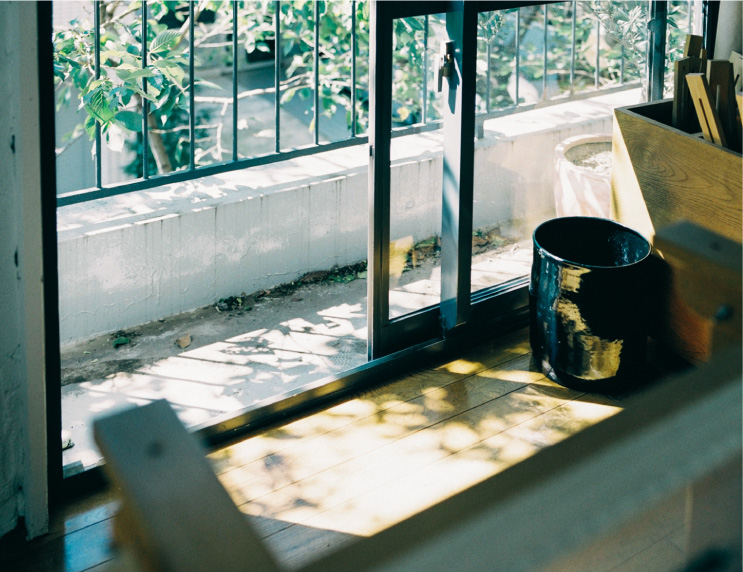
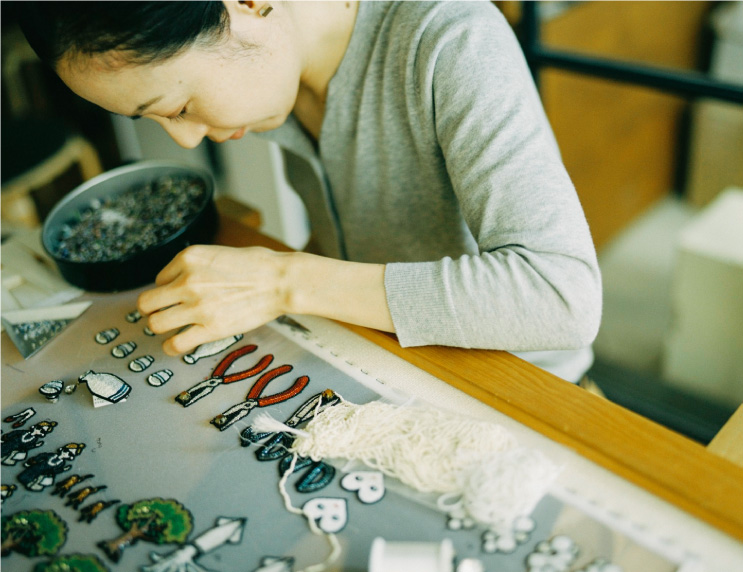


メゾン・ルサージュの伝統技法に魅せられて。
パリで学んだ生きていく強さ
A strength to live that she learned in Paris
「小学1年生の頃からミシンを使い、高学年になると買ってきた服をバラして、そこから型を取ってもう一着同じものを作ったりしてました」。母親の影響で、幼少期から洋裁に強い興味を持っていたモー子さん。高校を卒業するとパタンナーを目指し文化服装学院へと進学。山のような課題と格闘する学生生活を送る中、彼女の将来を大きく左右する出来事があった。それはパリのモード界を支える職人の作品や仕事を紹介する展覧会だった。そこでパリの伝統ある刺繍工房「メゾン・ルサージュ」による作品を目にしたモー子さんは、その精巧な刺繍技術に釘付けになった。「どうやって作っているのか少しも想像できないことが衝撃でした」。“こんな刺繍をいつかパリで学んでみたい”。この時芽生えた思いは、ファッションブランド、服飾会社と社会経験を積んだ彼女の心に再び火を灯すことになる。「学生時代の友人が、パリにある学校エコール・ルサージュに留学するという話を聞いて。わたしもいつか、と思っていた学校だったので、パリ行きへの思いが再びふつふつと湧き上がりました」。そしてモー子さんは2003年に仕事を辞め、翌年パリへと渡ることとなる。
“When I was six, I started to use a sewing machine. Several years later, I used to break up clothes that I had just bought, make the sewing patterns, and make the same thing again.” Môko has had a strong interest in dressmaking since childhood through her mother's influence. After graduating from high school, she went to Bunka Fashion College to be a fashion designer. In struggling with a pile of assignments, she met with something that influenced her future greatly; an exhibition of works by craftsmen in the fashion world of Paris. When she saw some works by a traditional embroidery atelier in Paris, Maison Lesage, she was glued to the delicate techniques. “What was sensational for me was that I couldn't even imagine how those works were made.” Since then, she had wanted to study such embroidery in Paris. After having some experience in a fashion brand and an apparel company, that idea came up to her mind again. “I just heard that a friend of mine from college would go to Paris to study at Ecole Lesage. Since I had wanted to study at that school someday, it stirred up my desire to go to Paris.” Môko quitted her job in 2003 and left for Paris the next year.

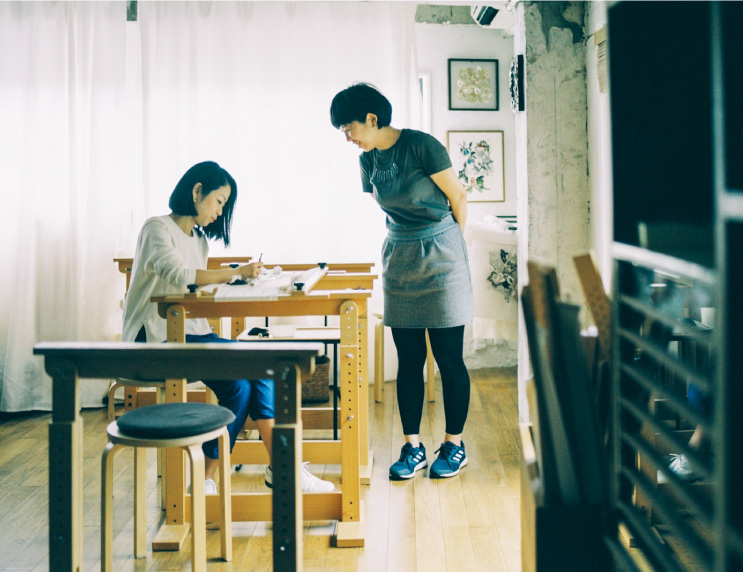
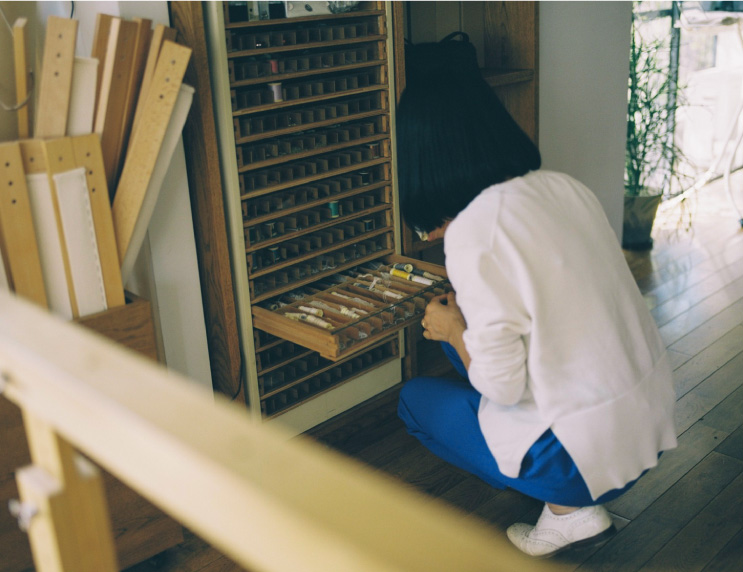
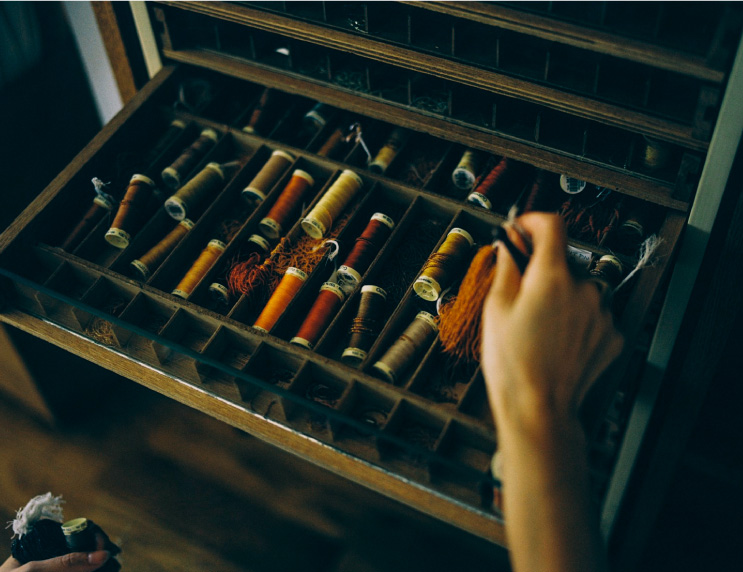
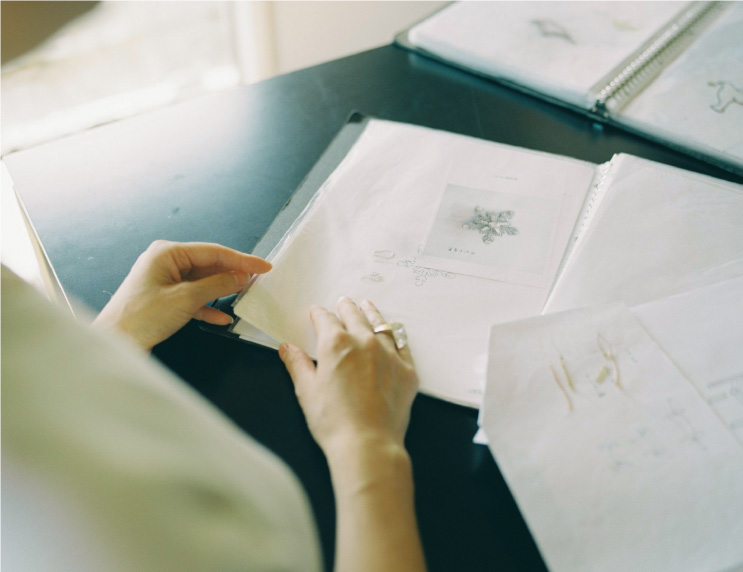
エコール・ルサージュはパリ唯一のオートクチュール刺繍の学校で、100年余りの歴史を持つ。週5日、みっちりカリキュラムを組み込み膨大な課題と格闘するモー子さんのパリ暮らしは始まった。「遊んだり休む時間はあまりなかったけれど、クロッシェを握って、糸やビーズを刺していく静かな時間が本当に好きでした」。伝統的な技術を守りながらも、革新を続けるオートクチュール刺繍の世界。その魅力にどっぷり浸かったフランスでの日々は駆け抜けるように過ぎていった。「もともとパリに憧れがあったわけではなく、刺繍を学びたい一心で渡仏したんですが、結果的にパリはオートクチュール刺繍の技術だけでなく、自分の人生を正しく楽しく生きる強さを身につけさせてくれたんです」。画家の大月雄二郎氏をはじめ、いくつもの重要な出会い。そして蚤の市で初めて知ったヴィンテージビーズの美しさ。奔走した7年間のパリ生活を通して、刺繍家としての未来をおぼろげに掴みながら2010年モー子さんは日本へと帰国することとなった。
Ecole Lesage is the only school for Haute Couture embroidery in Paris with a history of over 100 years. Her life in Paris started with a busy curriculum of 5 days a week and a pile of assignments. “Though I did not have much spare time, I really loved the quiet time to embroider with thread and beads holding a crochet in my hand.” The world of Haute Couture embroidery keeps on innovating, preserving the traditional techniques. Her days in France, totally immersed in the charm, passed by in a blink. “I went to France not because I had admired Paris or something. I purely wanted to learn embroidery. But as a result, I could acquire not only the techniques of Haute Couture embroidery but the strength to properly enjoy my own life.” In her 7 years in Paris, she had several important encounters; a painter Yojiro Otsuki, the beauty of vintage beads that she found for the first time in a flea market, and others. She came back to Japan in 2010 with a dim future as a needlework artist.

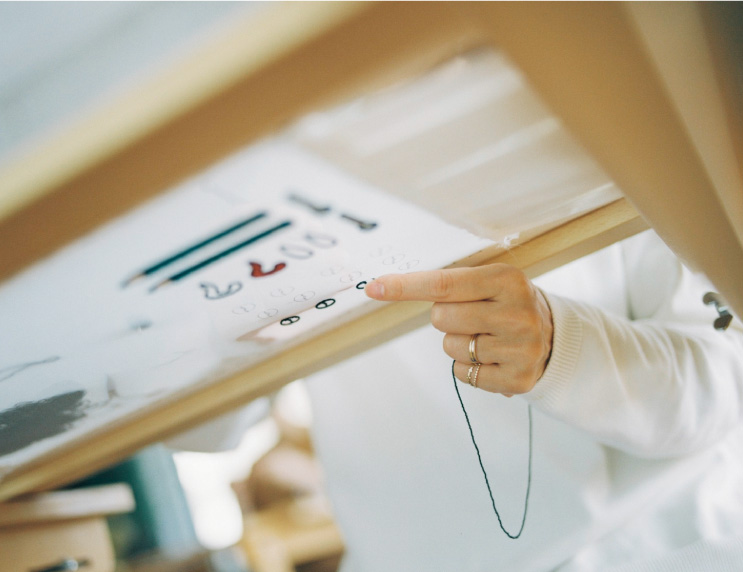
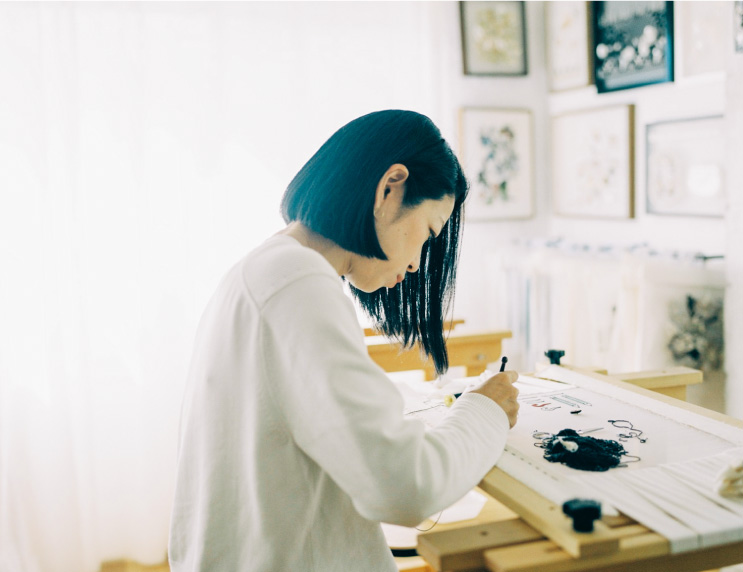
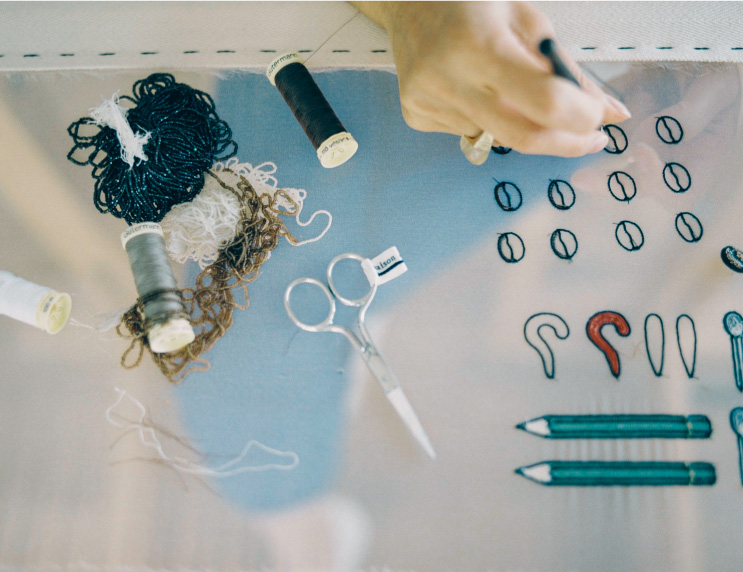
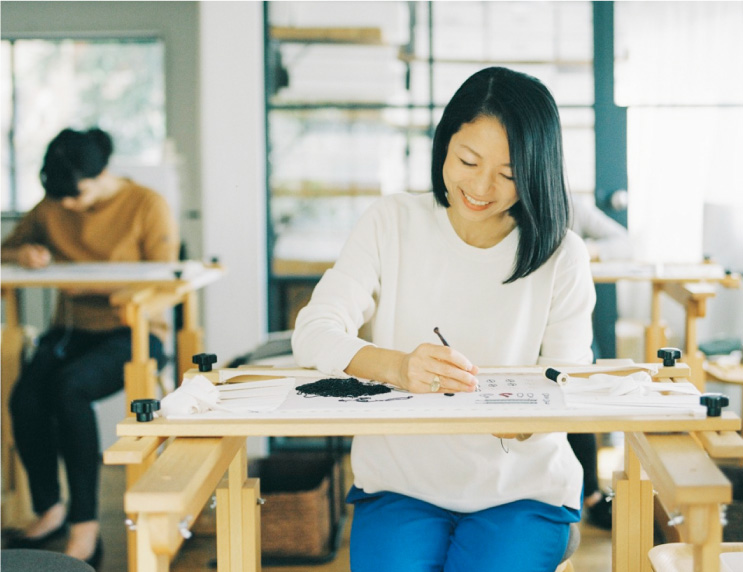
オートクチュール刺繍とヴィンテージビーズ
時を越えて生まれる新しい価値
A new value is created beyond the time
モー子さんの技術を支えるのは19世紀初頭に生まれた「クロッシェ・ドゥ・リュネヴィル」という伝統的なオートクチュール刺繍技法だ。オーガンジーのような薄く軽い素材にクロッシェ(かぎ針)を使って糸で刺繍を施す。これに彼女自身がヨーロッパ各地で集めた極小のヴィンテージビーズを用いることで、独特の繊細で品のある質感を実現している。「主に使うのは1930年代のヴィンテージビーズです。まずビーズそのものが素材として美しいんです。当時の職人たちの痕跡を小さな一粒一粒のビーズに見ることができます。今の精鋭化された技術では、逆に再現できない、不揃いで鈍くくすんだ独特の色が雰囲気ある美しさを生み出すんです」。オートクチュール刺繍の伝統に裏打ちされた技術、かつての職人たちが生み出した美しいヴィンテージビーズ。時を越え受け継がれた本物の技と素材が、小林モー子という刺繍家のイマジネーションによって新しい価値になる。
The base of Môko's technique is a traditional Haute Couture embroidery technique called “crochet de luneville”, which was born in the early 19th century. After embroidering on a thin and light textile like organdy with thread using a crochet, she applies tiny vintage beads which she collected in various parts of Europe by herself. Thus, uniquely delicate and elegant quality is created. “The vintage beads I use are mainly from the 1930s. More than anything else, those beads themselves are beautiful as materials. We can see a trace of the then craftsmen in each of those tiny pieces of beads. Those uneven, dull and unique colors, which are impossible to be duplicated with our contemporary picked technology, can create the distinctive beauty.” Her solid techniques backed by a tradition of Haute Couture embroidery and beautiful vintage beads made by the then craftsmen; those inherited genuine techniques and materials can be a new value by the imagination of a needlework artist Môko Kobayashi.
仲間がいるからできること。
メゾン・デ・ぺルルでつくる幸せなアトリエ
A happy atelier she makes in maison des perles
窓から眩しいほどの光を取り込むアトリエには、メゾン・デ・ペルルのスタッフたちが黙々とビーズと向き合う姿がある。ここで働くスタッフの多くはモー子さんの刺繍教室の元生徒たちだ。「刺し終わったモチーフは、必ずみんなでチェックします。みんなで見ることで共通の意識が持てるし、よりオリジナルに忠実な作品が作れます。ちょっとしたビーズの向きの違いで、表情が全く違って見えるんです」。モー子さんは、ここで生み出すものをアート作品ではなく、工芸品であり製品と位置付けている。だからこそ仲間たちの意見を聞き、他の人の良いと思うポイントを知ることが大切なのだという。
In the well-lit atelier, the staff of maison des perles is working silently with beads. Most of them are former students of Môko's embroidery school. “We always check the completed motif together. By checking together, we can have a common recognition and create works more faithfully to the originals. A slight difference in a direction of a bead can make a great difference in its appearance.” Môko regards the works created here as craft products rather than art pieces. That is why it is essential to ask my companions their opinions and grasp their taste, she says.

広告や雑誌、企業やアーティストとのコラボレーション、刺繍教室の運営、展覧会の開催。活動の領域が広がるほど、チームの力は不可欠だ。そんなモー子さんにとって、理想のアトリエとはどんなものなのだろう。「刺繍家として活動を始めた頃は、人と一緒に働くなんて思ってもみませんでした。こうして仲間ができたことで、乗り越えられた困難もたくさんあります。趣味と捉えられがちな手芸によって、会社をしっかり成立させることは重要だと思います。生産の現場が日本から他国に移っていく現状では、ものづくりをやりたい人たちが働く場所が、どんどんなくなってしまいます。一緒に働く人たちができたことで、ここをそんな作り手が安心して働ける場所にしたいと思うようになったんです」。小さなビーズのつながりが、人をつなぐ。モー子さんの幸せなものづくりの世界は、このアトリエを中心にまだまだ広がっていきそうだ。
Advertisement, magazines, collaboration works with companies and artists, management of an embroidery school, and holding an exhibition; the more her field of activity increases, the more essential it becomes for the team to unite. I wondered what the ideal atelier for Môko would be like. “When I started as a needlework artist, I wasn't expecting at all that I would work together with someone. But there were indeed a lot of difficulties that I could overcome because I was not alone. I believe that it is meaningful to run a company steadily by handicrafts which are often regarded as hobbies. Nowadays, production sites are moving to foreign countries from Japan and the workplaces for those who want to pursue creative activities are disappearing. After I got my companions, I became to think that I want to make a safe place for those creators to work without any anxiety.” The connection of tiny beads connects people. Her world of happy creation will keep on expanding with this atelier as its center.
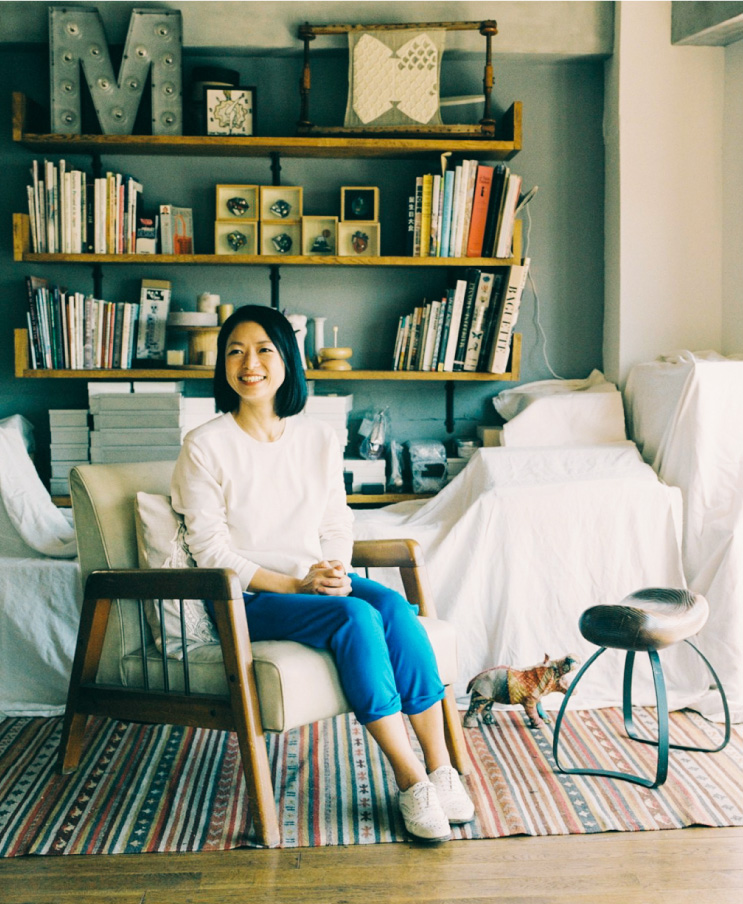
PROFILE
刺繍家 。アトリエ『メゾン・デ・ぺルル』主宰 。1977年、神奈川県茅ヶ崎市生まれ。1999年、文化服装学院アパレル技術科卒業 。1999〜2003年まで服飾メーカーにてパタンナーとして勤務する。オートクチュール刺繍を学ぶため、2004年、渡仏。パリの刺繍学校『Ecole Lesage broderie d’Art』にて技法を学び、ディプロムを取得 。2010年、帰国。刺繍アクセサリーの制作を本格的に開始し、『メゾン・デ・ぺルル』設立。同時にオートクチュール 刺繍の教室も始める。2015年、東京・渋谷区西原にアトリエを移転 。2016年、インテリア刺繍を学ぶためパリ『Ecole Lesage broderie d’Art』へ、またロッシュフォール『Atelier begonia d’or』では、Maître d’Art (仏版人間国宝)のSylvie Deschampsにゴールドワークを学ぶ。現在、ヴィンテージビーズを用いた刺繍アクセサリーの制作を軸に、雑誌・広告などで幅広く活躍中 。
Môko Kobayashi is a needlework artist and the owner of an atelier “maison des perles”. Born in Chigasaki, Kanagawa in 1977, she graduated from apparel technology course at Bunka Fashion College in 1999. From 1999 to 2003, she worked as a pattern maker at a fashion brand and in 2004, she left for France to study Haute Couture embroidery. She learned the technique at Ecole Lesage broderie d'Art and acquired her diploma. After coming back to Japan in 2010, she started creating embroidered accessory, established “maison des perles”, and opened a class of Haute Couture embroidery. The atelier was moved to Shibuya, Tokyo, in 2015. In 2016, she left for Paris to learn interior embroidery at “Ecole Lesage broderie d'Art”. Also, in Rochefort, she learned Goldwork embroidery at “Atelier begonia d'or” from Sylvie Deschamps, Maître d'Art (Master of Art). She is now active in various fields such as magazines, ad, or others, with the creation of embroidered accessory using vintage beads.
A Favorite Spot in Tokyo
訪ねたい場所、会いたい人
BONDO
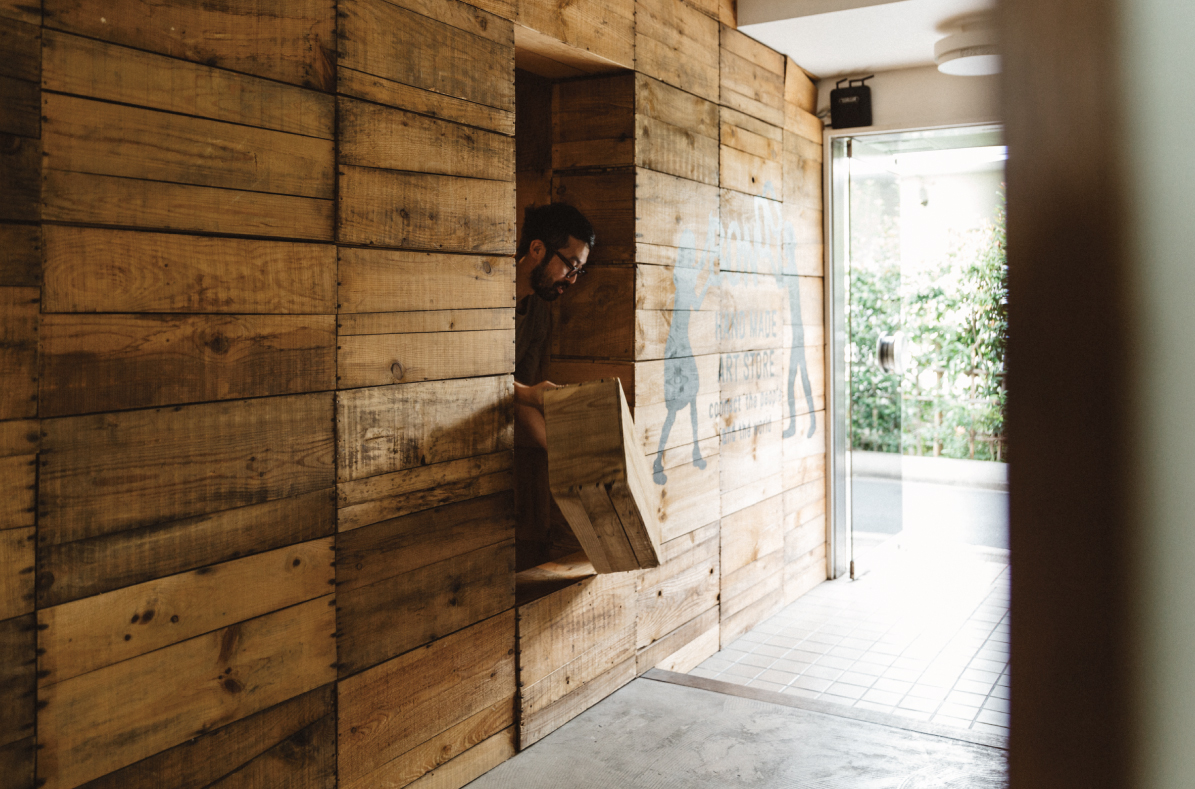
創造の深みに思いを馳せて
作り手に寄り添う妥協のないもの選び
Thinking of the profundity of creativity
The uncompromising selection which is considerate to the creators
作り手に寄り添う妥協のないもの選び
The uncompromising selection which is considerate to the creators
今回小林モー子さんのアトリエを訪問するにあたって、その橋渡しをしていただいたのは吉祥寺にあるセレクトショップ〈BONDO〉の店主、村上雄一さん。作り手に寄り添うような創作への深い理解からなるセレクトは、顧客だけでなく作家からも厚い信頼を寄せられる。「機能美の先にある何か。言葉にできない底知れぬエネルギーを持った作品に惹かれます。
小林モー子さんのビーズの刺繍作品もそうです。うまく言葉にできないけれど、作家が創作の過程で深く潜った作品には研ぎ澄まされた凄みを感じるんです」。BONDOで取り扱うのは陶器や木工品、服飾品やアクセサリーなど、それぞれに独自の感性を持った作家によるハンドメイド作品だ。気に入った作家がいれば展示会に足を運び、まず客として作品を購入するのだと村上さんはいう。「暮らしの中で実際に使ってみることで、作家たちが創作の中でつかんだ本質を感じることができるんです」。店の両側に組まれた木箱に並ぶ作品を手に取れば、作家たちの深い美意識がじわりと伝わってくるようだ。

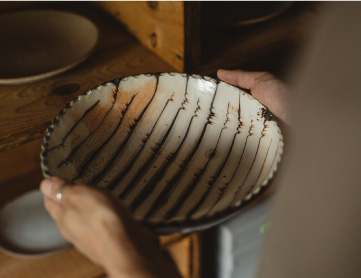
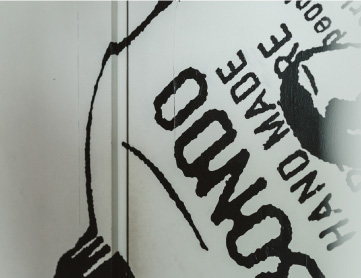

We had a chance to visit the atelier of Môko Kobayashi this time through Yuichi Murakami, the owner of a select shop “BONDO” in Kichijoji. His selection, which comes from his deep understanding of creativity, is considerate enough to the creators. It is deeply trusted by not only his customers but creators. “The works that attract me possess indescribably bottomless energy, something beyond functional beauty, just like the beads embroidery works by Môko Kobayashi. Though I cannot put it into words well, I feel perfectly clear awesomeness from the works whose creators went into deep thought in the process of creation.” He handles handmade products in BONDO such as pottery, woodwork, clothing, and accessories, by uniquely talented creators. When he finds a good creator, he goes to his/her exhibition and purchases some works as a customer first. “By actually using those works in my daily life, I can feel the essence that the creator grasped in the process of creation.” If you pick up a piece of work displayed in wooden boxes on both sides of the shop, you will feel the deep sense of beauty of the creators.
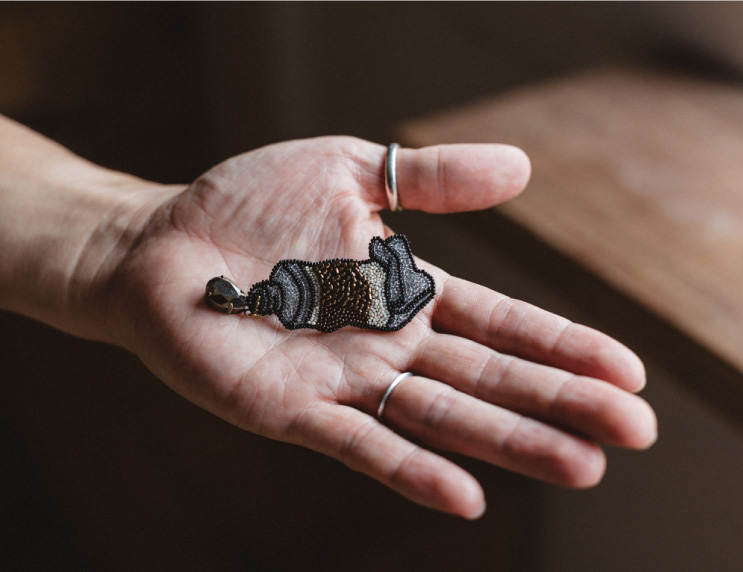
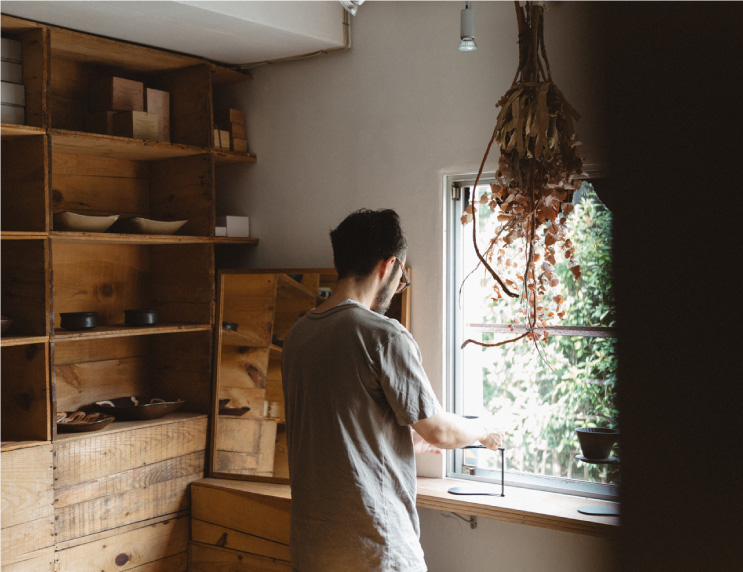
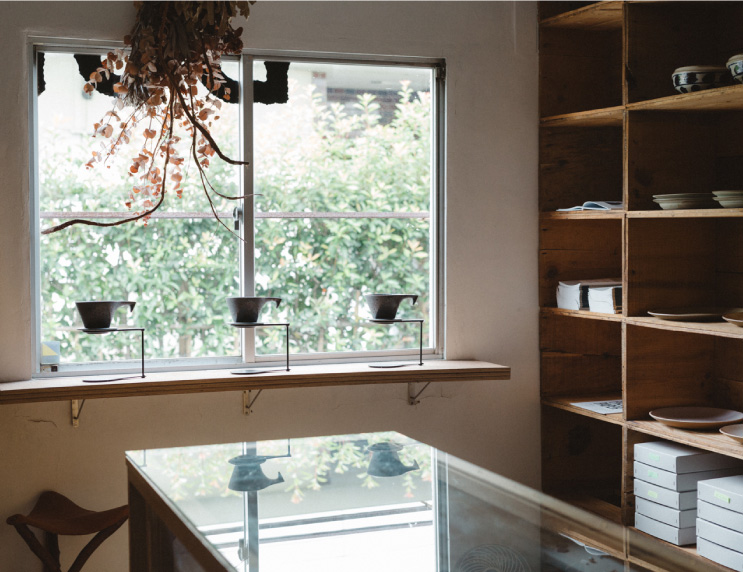
広告代理店、制作会社を経て独立した村上さんは、7年前に〈BONDO〉を開店させた。「会社員を辞めた時に、これからは自分自身になるたけ嘘のない生き方をしようと決めたんです。このお店を始めたのも、本当に興味のあることを仕事にしたいと思ったから。自分の直感や興味を尊重することは、幸せな生き方に直結していると思うんです。かつてはお金で買えるものに執着していたこともありましたが、それではいつか行き詰まるのではないか。そこに気づけたから今があるんです」。一人一人の作家について、自身の経験を交えたエピソードを楽しそうに語る村上さん。多くの作り手たちの仕事を見つめ寄り添いながら、棚に並べる作品を吟味してきたに違いない。それは作家たちの妥協ないものづくりへの敬意と共感の表れでもある。「最終的には嘘のない人生を送っている作家さんの作品を選んでいます。そうじゃないと深い創作はできないと思いますから。多少浮世離れしてても、そんな作家さんとはずっと仕事をしていきたいと思うんです」。作り手の深い美意識と熱に触れること。その豊かな喜びを木箱に囲まれたこの空間が静かに教えてくれる。
After experiencing an ad agency and a production company, Mr Murakami opened BONDO seven years ago. “When I quit my previous job, I decided to live without lying to myself. The reason why I started this shop was that I wanted to work with what I was truly interested in. To respect your intuition or interests must be directly connected to your happy way of living. There was a time when I clang to things I could buy with money, but I realized that such way of living could go nowhere. So, I am who I am now.” Mr Murakami cheerfully told us lots of interesting episodes about each creator, describing his own experience. He must have been examining the works to be displayed on the shelf, watching and considering the works by quite a number of creators. It must show his respect and empathy to the uncompromising creation of the creators. “In the end, I select those works whose creator live a sincere life. If not, I don't think a deep creation is possible. Even if the creator lacks a bit of worldly sense, I hope to work together with him/her for a long time.” This space, surrounded by wooden boxes, will gently tell you the fruitful joy of touching the deep sense and energy of creators.
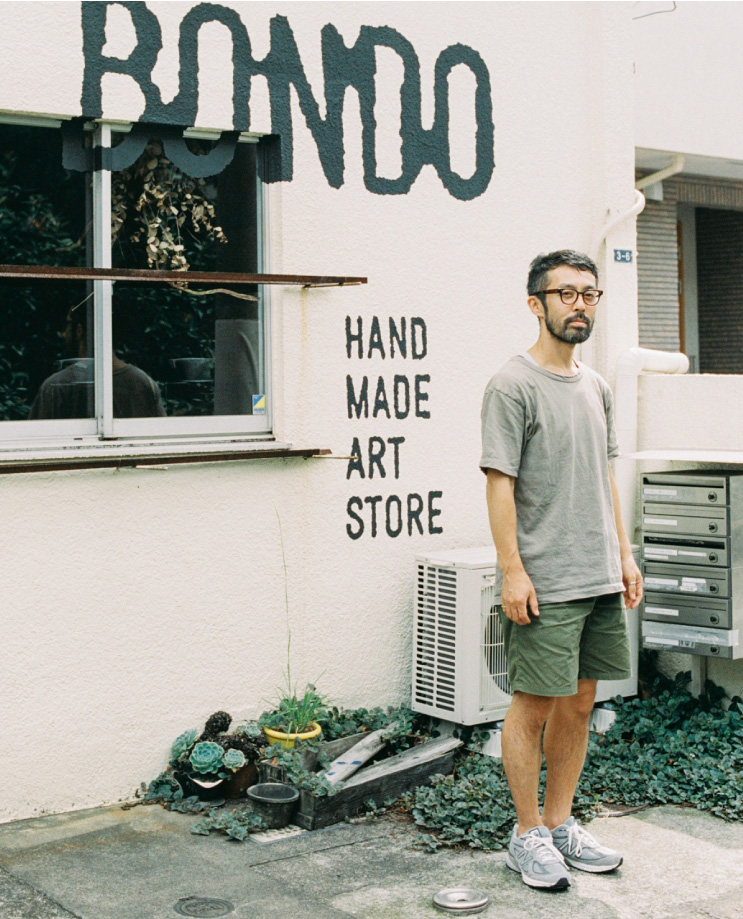
〒180-0004 東京都武蔵野市吉祥寺本町3-3-6 Arts&Crafts 1F
TEL:0422-67-3964 営業時間/12:00~18:00
定休日/火曜日・木曜日(祝祭日の場合は翌日)
1F Arts&Crafts 3-3-6 Honcho Kichijoji Musashino-shi, Tokyo 180-0004
TEL:+81 0422-67-3964 opening hours/ 12:00 pm -18:00 pm
Closed on Tuesdays and Thursdays (the following day if it is a national holiday)
